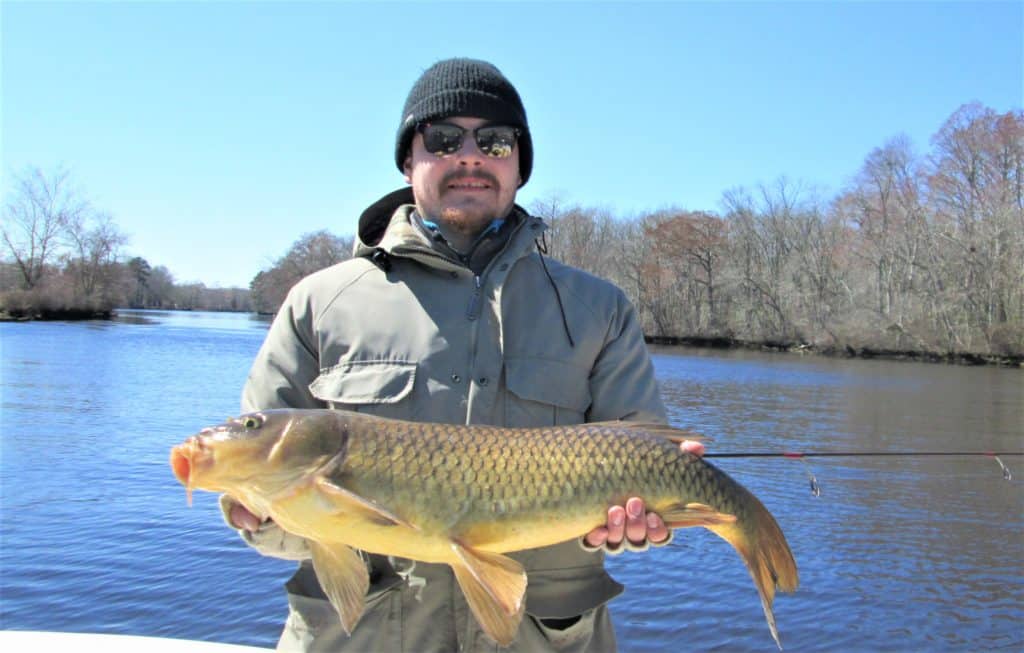Sporting Life

The Ubiquitous Carp: Another early colonist to America
By Dennis Doyle
We were bundled up against the 40-degree weather but our cooler was crowded with the fat, golden, green ringed, yellow perch that were in the midst of their big spawning surge on the Pocomoke River. We also had some fat white perch that had begun their run a little early. These two species are arguably the best eating fish available anywhere on the Chesapeake and our larders had been empty of fresh fish for too many months.
Getting ready to call it a day and head for the cleaning table, my son had one last hook up. His rod bent down to the gunnels as he set the hook and the drag began screaming bloody murder. At first we thought it was a big pickerel, as they often follow the perch runs to pick off unwary neds and to feed up for their own spawn, due shortly.
Patiently lifting his rod and wisely ignoring my suggestion to tighten his drag, we eventually got a look at the monster—it was a carp and quite a large one. There were moans of disappointment in the boat, it wasn’t one of the more desirable species we were after, but those sounds didn’t come from Harrison. He remained properly enthusiastic. It was the biggest and strongest fish by far he’d ever tangled with and he did not intend to lose it.
We were jigging light, 6-foot spin rods, spooled with 6-pound mono and armed with 1/6-ounce shad darts and angling for yellow perch. It was our second or third year at starting a new tradition of fishing promptly after the New Year and there were four of us: son Harrison, my brother Bill Doyle, and Randy Steck, a long-suffering friend who insisted on sharing all of our more uncomfortable adventures.
Carp fish originally came to America with the early European colonists fleeing religious persecution, poverty, hunger, disease, tyrannical aristocracies and generally dismal lives throughout the Continent. They brought with them just a few things to assist their success in living in the New World. Among them were live carp fish.
Carp proved an extremely hardy food fish that could tolerate high degrees of crowding as well as withstanding the two month sail across the ocean. They thrived in almost any waters to which they were introduced, multiplied easily, could even be raised in small ponds, had a good flavor, grew to very large size and were resistant to parasites and diseases. Legend has it that the very first live carp were released into a Baltimore City lake in the 1800s and from there it spread out through the colonies.
It’s news to many anglers today that they are also quite numerous throughout the Chesapeake, its tributaries and in Maryland’s many fresh water impoundments. The fish are known to reach 100 pounds and live up to 30 years or more. The reason Tidewater anglers do not encounter them more often is that their diets consist of mostly plants, aquatic vegetation, insects and berries.
If you’re not fishing specifically for carp you probably won’t catch any. To hook a few, try carp corn boilies and doughballs, traditional baits, as well as corn kernels, tiger nuts and just plain white bread kneaded into thick dough. There are myriad commercial carp baits as well as special personal recipes for complicated bait concoctions that go back generations. Carp bite well throughout the year including during the winter months.
Chumming for carp with cooked corn, rice, wheat, dog food, or poultry pellets smashed and suspended in porous cloth bags can draw them into a concentrated area as can saturating an area in prior days with hard corn or rice. It’s a whole angling technique to itself.
Try it sometime—they provide an entirely new fishing adventure. But be sure you use strong tackle, stout hooks no larger than 1/0, and keep your baits on the bottom.
